Mustard algae or sand – How to Know (with Pictures)
You can tell if you have mustard algae and not sand or dirt by identifying where the “dust” is located and how it reacts when touched and brushed. If it’s slimy, situated in the shade, clouds when brushed, appears on walls or is challenging to pick up, it’s likely mustard algae. You can also place the dust in a bucket of pool water and see if it grows. Chlorine levels will drop over 1 ppm overnight if algae is present in the pool as well.
Mustard algae can be a simple one to identify and fix or it can be stubborn and baffle even the most experienced pool experts. I’ll detail how you can identify mustard algae (yellow algae) below by listing the core differences, along with some helpful pictures.
I’ll also provide some removal and prevention resources for both algae and sand.
Chlorine Levels Overnight will Drop if there is Algae in the Pool
A sure way to test if you have mustard algae in your pool is through an overnight chlorine loss test (OCLT). This will test the chlorine levels overnight when the sun is gone to see if organic matter is consuming it. If the test shows chlorine levels drop by more than 1ppm, you likely have mustard algae.
An OCLT works because chlorine is removed from a pool in two ways: via the sun and via organic matter, such as algae. By testing chlorine levels overnight and then testing them again in the morning, you can eliminate the sun as a variable. This allows you to identify if chlorine is being consumed by algae or organic material.
To prepare for an OCLT, you need to first make sure you have the correct test kits. From my and others’ experience, you’ll need to use a FAS-DPD test. This is a titration or drop count test for both free chlorine (FC) and combined chlorine (CC) that can be found in the TF-100 or K-2006.
Some Advice for my UK Friends
FAS-DPD tests are very difficult to find in the UK and Europe. From talking to friends of mine and through reading threads in forums, importing them costs a lot of money. I’ve heard you should either search for the individual reagents for the Taylor kit or use something like a Lovibond Scuba 2.
The reason we use a FAS/DPD test is that it’s much more accurate and will provide precise readings. Avoid using the OTO test found in the Taylor K-1000 – although it’s a great kit it doesn’t provide the precise chlorine readings we’ll need when performing an OCLT.
Before performing the test, avoid adding any chlorine to the pool and wait until the sun has gone down completely. Also, remove any chlorine tablets and turn off your salt water generator (if you have one). Then, 30 minutes after your last chlorine addition, test the chlorine levels using your kit. This will give you a starting point.
Then, in the morning, take the final reading to see if there has been any drop in chlorine levels. Make sure to wake up before sunrise to get the final reading, otherwise, it won’t be accurate.
If the FC levels recorded from the FAS-DPD test have gone down by more than 1ppm, you have algae in your pool.
It’s important to note that this test doesn’t specifically test for mustard algae – it tests for organic material and algae generally. However, if you can see something in your pool with your own eyes, this test gives you certainty you’re dealing with algae and not sand.
Mustard Algae will Cloud When Brushed
If the dust or material clouds when you brush it, it is likely mustard algae. If you brush it and it simply moves around, it’s probably sand or dirt.
It’s worth noting that sand can also be a little difficult to get off occasionally. Whereas, mustard algae will scrape off pretty easily.
You can also get a manual vacuum on it, wait a day or so, and then see if it returns in the same spot. If it does, it could be mustard algae.
Mustard Algae Feels Slimy and is Hard to Pick Up
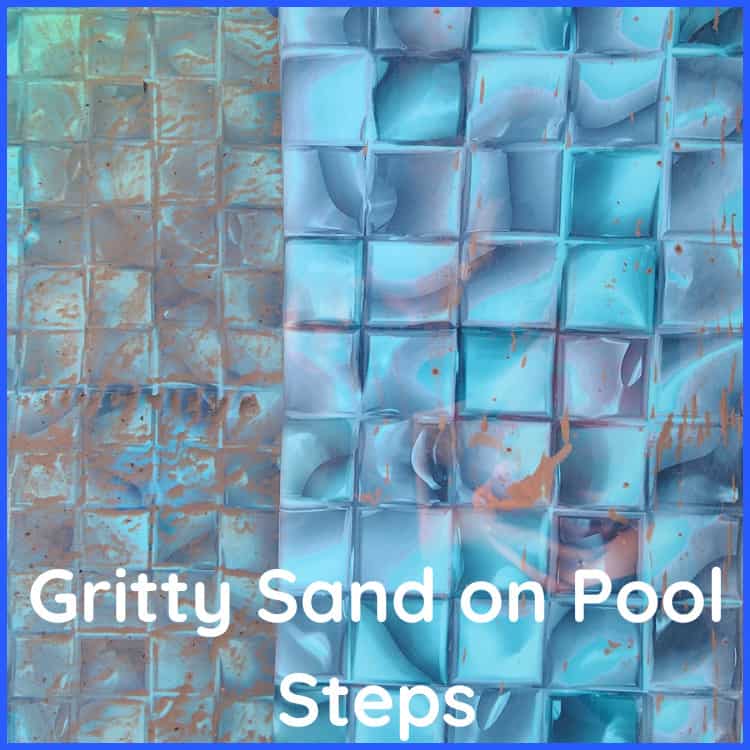
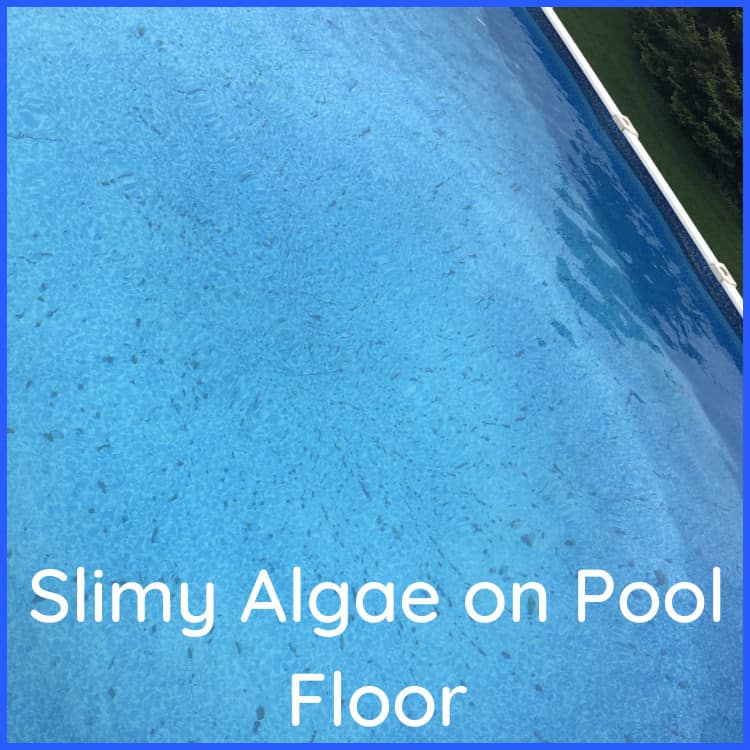
If it feels slimy, it is likely mustard algae. If it feels rough or coarse (like sand), then it’s probably sand.
Get a good brush and scrape some off. Rub it between your fingers and see how it feels. Again, if it’s obviously slimy, it is likely to be algae.
In fact, if you’re having a hard time picking it up in the first place, this is a good sign you’re dealing with mustard algae.
If you can pick it up and it feels brittle or harder than sand, it could be calcium. This would then require a whole different type of solution.
Mustard Algae will Climb Walls (Unless Chlorine is Low)
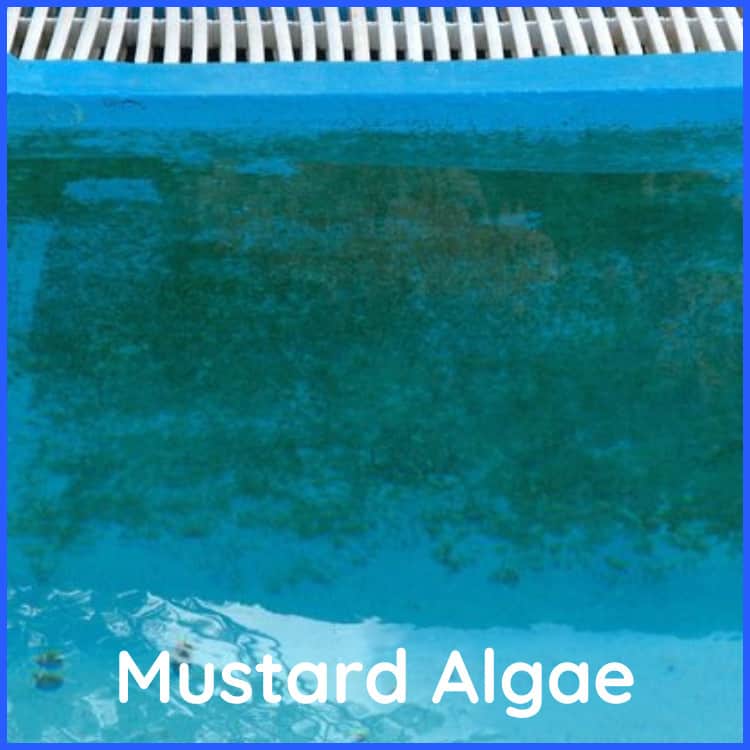
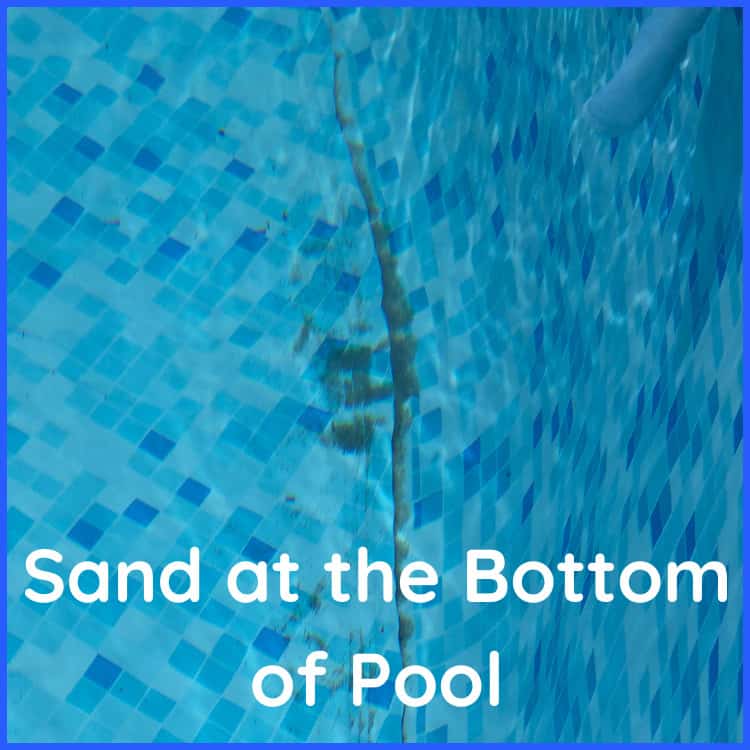
If the dust or material is sticking to the walls of your pool, it is most likely mustard algae. Sand will not stick to the sides as it’s too heavy. It will fall and sit at the bottom, often near the return lines.
I have also heard mustard algae can free-float in the water if the chlorine is low enough. I’ve never personally seen this but individuals over at Trouble Free Pool have reported it can happen.
If the yellow dust is on the walls, you can also rule out pollen as this falls to the bottom as well.
There is a small chance it could be calcium, as scaling can occur on the walls of your pool. However, a touch test (detailed above) will tell you if this is the case. Calcium is very hard.
Mustard Algae Prefers Shade
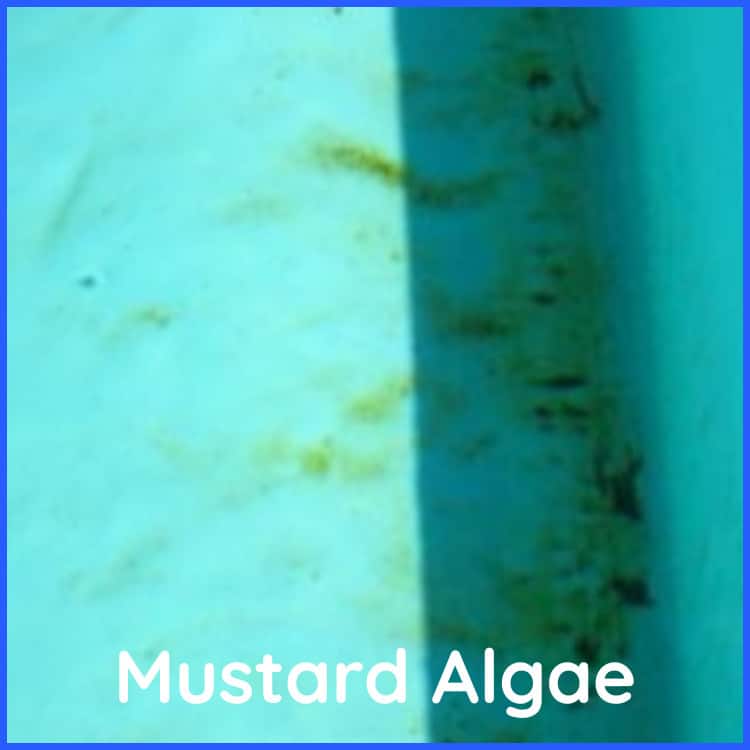
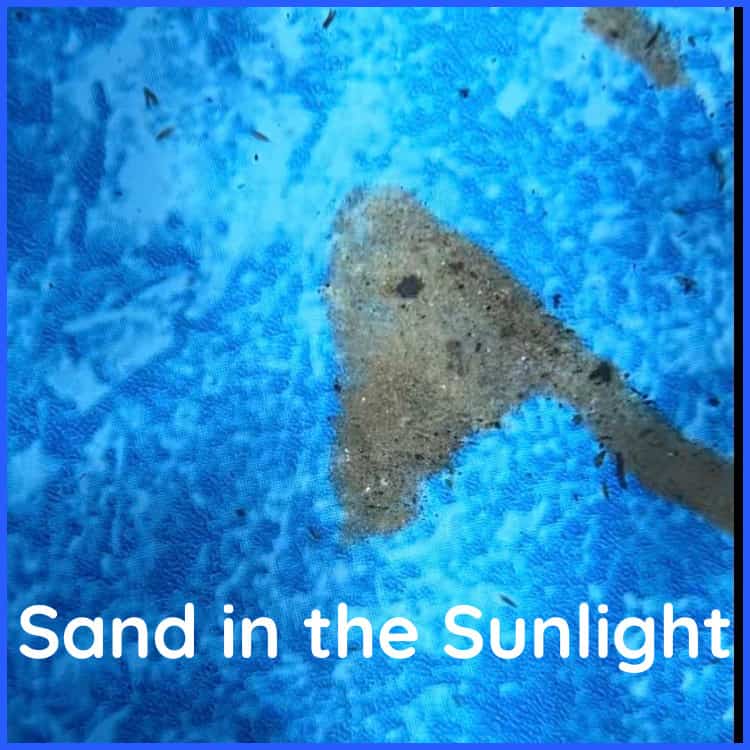
If the yellow material is ONLY situated in shaded areas of your pool, it could be mustard algae. Mustard algae prefers shade, whereas sand will be everywhere without any obvious pattern.
Again, this can also rule out pollen. Like sand, pollen doesn’t care if it’s sunny or shady – it’ll be everywhere in your pool.
Mustard Algae Prefers Areas of Poor Circulation
If there is material is situated in areas of poor circulation, there is a chance it good to be mustard algae. This allows it to stay in one place and grow undisturbed.
However, this isn’t a great way to determine if it is algae beyond doubt. You should combine this with other tests in this article just to be sure.
Mustard Algae Can Grow if Your Shock Level Drops
If you have a lower free chlorine (FC) level (shock level) compared to your cyanuric acid (CYA), mustard algae can grow and thrive. If you brush the materials and raise your shock level by increasing free chlorine, and the yellow dust disappears, there was a good chance it was mustard algae.
This is a more complicated approach but an effective one. It does require knowledge about the SLAM method popularized by the community at TFP.
Also, to get rid of mustard algae completely, you’ll need to raise the FC level to extra-high mustard algae shock level for 24 hours. You can use this chart as a reference.
However, by learning how to SLAM your pool effectively, you can reduce the number of hours you spend maintaining its hygiene.
Mustard Algae will Grow if Placed in a Bucket of Water
If the dust grows or expands when placed in a bucket of pool water over the course of 1-2 days, it is probably mustard algae. Sand isn’t a living thing, so it shouldn’t expand or multiply when left in water. I know it’s obvious but I had to say.
This is known as the ‘bucket test’ or ‘jar test’. It’s a good way to test for algae but it can take time to wait for the algae to grow. In the meantime, if it is algae, it’s slowly infesting your pool.
If You Think it’s Mustard Algae, Here’s How to Remove it
The simplest and most well-known way to get rid of mustard algae is through aggressive pool shocking. However, there are a few steps before that.
Wash Your Swimwear and Inflatables Thoroughly
First, wash any bathing suits swimming shorts, and inflatables that have been in the pool. Mustard algae gets into pools from outside sources like swimwear.
For the clothes, it is better to use a color-safe bleach. For the inflatables and pool toys, use chlorine-based bleach and wipe them all down.
This is something that is recommended but not always necessary. It’s just a solid way to ensure the algae is doesn’t come back with vengeance. Algae is an airborne material, so cleaning your trunks and equipment isn’t always the most effective way to prevent it, but it helps.
Scrub the Pool with a Brush and Vacuum the Debris
Now you’ll need to loosen the algae up by brushing and scrubbing it from the pool surface. This will make the shock more effective when you go to add it.
It’s important to use the right brush when doing this:
- For concrete pools, use a metal brush
- For vinyl or fiberglass pools, use a plastic brush that has thick bristles
Try and get the majority of mustard algae off the surfaces. Any you can’t get can be vacuumed. However, if you are going to vacuum, use a manual one and set it to waste. Don’t vacuum and circulate the algae back into the pool.
Also, don’t just brush the infected area. You need to thoroughly clean the entire pool! This includes all sides, steps, skimmers, lights, etc. Everything needs to be cleaned with disinfectant or bleach. Don’t miss anything out otherwise you may have to do it again.
Test and Balance Your pH and Alkalinity
Before throwing in the shock, make sure your pool is balanced. You will want the pH to be between 7.4 and 7.6. Alkalinity should be 100-150ppm.
This will make sure the chlorine is the most effective when you add it as chlorine works best in a neutral chemical environment.
Triple Shock the Pool with Calcium Hypochlorite (at Night)
Once you have the pool balanced, wait until the sun has gone down before adding your shock so the chlorine is as potent as it can be. The recommended shock is calcium hypochlorite. However, you can also use dichlor or trichlor if don’t want to increase your calcium hardness too much (although using shock, in general, will increase mineral content, thus increasing pool hardness).
You’re going to triple shock your pool by adding 3 lbs of shock for every 10,000 gallons in your pool. Do this with the pool pump running and leave it for 24 hours. We want FC levels to be between 25 ppm and 30 ppm.
The reason we triple shock is because mustard algae is resistant to chlorine.
Brush and Balance Again (and Shock Again if You Need to)
Once you’ve shocked your pool for the recommended time, give the pool another brush and clean. You want to make sure the algae is completely gone and off the surfaces.
Also, test your water again to make sure pH and alkalinity are balanced. You want the chlorine to be as effective as possible.
After a few days, if you want to make sure it’s gone for good, add some more shock. But only add 1lb for every 10,000 gallons. That should do the trick to get rid of any extra algae.
What Happens if it Doesn’t Go?
Mustard algae is stubborn and hard to get rid of. If the above doesn’t seem to be working, you can always move to harsher chemicals, like algaecides. However, these can leave nasty side effects because of their heavy metal content. I don’t recommend using them.^^Add link to why algaecides are bad article you’ll write in the future^^
You can also try adding phosphate remove when adding chlorine to remove the algae’s food source. Phosphate remover is also a good prevention strategy.
Because mustard algae can be a pain to remove, I have created a separate article that goes into more depth about removing it. It will cover some methods to remove really stubborn mustard algae and provide some examples of how others have dealt with the issue. I’ll link it below.
If You Think it’s Sand, Here’s How to Remove it
If you’re lucky and it is sand, all you need to do is vacuum it up. A manual vacuum will work best here. However, a robot cleaner will also work, just not as thoroughly.
You can often vacuum the sand straight into the filter. However, if you don’t think the material is sand, you can also be cautious and vacuum to waste. Just be willing to top up the pool once you’re done.
Additionally, sand shouldn’t hurt your pump’s impeller either. If you are worried, you can always use a pre-filter.
How to Prevent Mustard Algae from Coming Back
Keeping your pool free from mustard algae is the easy part. There are several ways to do this:
- Keep the chemicals balanced: Make sure to maintain balanced pH, alkalinity, and sanitization levels.
- Keep shock levels high (SLAM): If you’re using the SLAM pool method, you need to keep to your correct shock level.
- Shock Weekly (non-SLAM): If you’re not using SLAM, shock weekly with 1lb of shock for every 10,000 gallons of pool water.
- Wash and wipe accessories regularly: Make sure to wash your toys, accessories, and swimwear with bleach and disinfectant regularly.
- Keep your pump and filters running: Make sure to run your pool pump and filters 8-12 hours a day.
- Add phosphate remover: Phosphate is what algae feeds on in your pool. Add a few ounces after you’ve removed the algae to remove the food source.
How to Prevent Sand from Getting in Your Pool
The best way to prevent sand in your pool is by covering it when you’re not using it. This will prevent wind from carrying any in.
Also, if you use a sand filter, it could have cracked resulting in sand leaking into the pool. So, make sure to check your sand filter regularly and keep it maintained.
